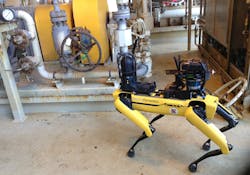Michael Perry, Boston Dynamics
Mad Dog, BP’s offshore platform in the deepwater Gulf of Mexico, has a new addition: Spot. The quadruped, agile robot from Boston Dynamics made its debut last month as part of BP’s commitment to reaching net-zero emissions by 2050 and boosting employee safety and operational efficiency.
Robots have long been a focus for BP’s team. Earlier this year, the company purchased Spot through Boston Dynamics’ early adopter program, with the objective of utilizing the robot to remove employees from potentially hazardous situations and physically demanding environments on offshore sites. The simplest day-to-day tasks – such as performing operator rounds, reading gauges, listening to equipment, scanning horizon, “tending to the plant,” sniffing for methane, identifying and quantifying potential leaks in hard-to-reach locations or enclosed spaces – can be complicated by the surrounding environment.
Using Spot to tackle these general housekeeping items frees up this labor intensive and taxing work, allowing experienced specialists to spend their time on more complex and high-impact activities. The robot, for example, has been integrated into walking rounds to look and alert for leaks, in addition to performing online electrical inspections in areas that a human cannot safely enter. And by equipping Spot with sensors, the robot is used to go beyond human capabilities to capture IR, ultraviolet and hyperspectral data.
Spot’s deployment to Mad Dog comes after extensive testing and digital development. Before considering the robot for deployment to its offshore rigs, the BP team performed proof of concept trials where Spot was tested on gravel pads and ramps, narrow passages and confined spaces, as well as grated platforms and eventually tested in a live onshore environment.
“A big piece of implementing this technology is setting the right mindset,” said Adam Ballard, facilities technology manager. “We chose to do an extended trial of at least three months to take the novelty away. We have to get to a place where the robot is less like a toy and more like a tool.”
In addition to improving worker safety, BP is also using Spot to improve operational efficiency, as well as to help the company reduce its carbon footprint. Using Spot to consistently gather data with sensor packages such as methane detectors and audio sensors, for example, allows BP to identify equipment abnormalities before a production facility trips occurs, ultimately reducing the amount of flaring. This includes pressure temperature readings; identifying position of values and ultimately identifying if it is open or closed; if there is corrosion, and how severe it is. The robot is also being used to gather larger data sets on equipment performance, including laser scanning, acoustic data, general visual, close visual and thermal. Additionally, Spot can reduce onsite personnel by being the eyes, ears and nose on the rig, ultimately minimizing transportation requirements.
“Our first step in development and deployment is having the robot perform activities a human could perform,” Ballard added. “However, in the future we plan to do much more, for example integration of multispectral and hyperspectral imaging to ‘see’ things humans cannot.”
BP says that it will continue to utilize Spot on Mad Dog for the next few months and plans to expand the robot’s job duties to other offshore fields.
“It’s not about reducing people,” Ballard concludes. “It’s more about utilizing people’s strengths, and augmenting their experience and judgment with Spot’s capabilities, to make their work more data-driven to accomplish our goals.”



